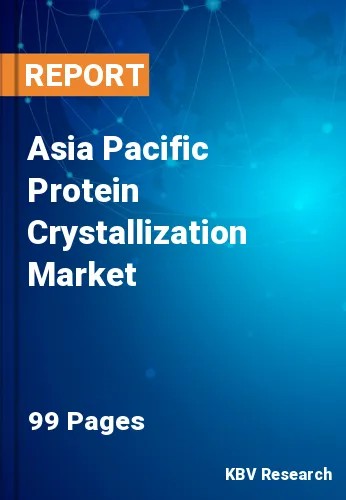The Asia Pacific Protein Crystallization Market would witness market growth of 9.3% CAGR during the forecast period (2022-2028).
Proteins are dissolved in an aqueous environment and kept in specimen solution throughout the crystallization process until they reach the supersaturated state. Many methods like vapor diffusion, microdialysis, micro-batch, and free-interface diffusion are used to achieve such conditions. Several variables, including pH, temperature, the ionic strength of the crystallization solution, and even gravity, may impact the intricate process of developing protein crystals.
Once generated, these crystals may be used in structural biology to investigate the protein's molecular structure, especially for various commercial or therapeutic objectives. Many techniques, such as X-ray diffraction or X-ray crystallography, small-angle X-ray scattering, cryogenic electron microscopy (CryoEM), and neutron diffraction, may identify macromolecular structures from protein crystals. In addition, the formulation of proteins for use in pharmaceuticals may also benefit from protein crystallization.
China's healthcare industry is one of the most thriving in the world, and it presents opportunities for US exporters in several secondary healthcare fields. However, the most active and crucially important area for businesses remains medical equipment in the healthcare industry. Malaysia's healthcare expenditures are expected to quadruple to USD 2.8 billion by 2028. The government has emphasized public healthcare and allocated USD 7.7 billion to the MOH (Ministry of Health) for operation and development expenditures to increase national resilience ahead of the pandemic phase of COVID-19. MOH will get the second-largest funding from the National Budget for 2022. The healthcare system concentrates on options for senior care since 10% of the population is over 60.
The China market dominated the Asia Pacific Protein Crystallization Market by Country in 2021, and would continue to be a dominant market till 2028; thereby, achieving a market value of $151.2 million by 2028. The Japan market is estimated to grow a CAGR of 8.7% during (2022 - 2028). Additionally, The India market would experience a CAGR of 10% during (2022 - 2028).
Based on End User, the market is segmented into Pharmaceutical & BioProduct Companies and Academic & Research Institutes. Based on Technology, the market is segmented into X-ray Crystallography, Cryo-electron Microscopy, NMR Spectroscopy and Others. Based on Product, the market is segmented into Instruments, Consumables and Software & Services. Based on Instruments Type, the market is segmented into Liquid Handling Instruments and Crystal Imaging Instruments. Based on Consumables Type, the market is segmented into Reagents & Kits/Screens, Micro Plates and Others. Based on countries, the market is segmented into China, Japan, India, South Korea, Singapore, Malaysia, and Rest of Asia Pacific.
Free Valuable Insights: The Worldwide Protein Crystallization Market is Projected to reach USD 1.8 Billion by 2028, at a CAGR of 8.4%
The market research report covers the analysis of key stake holders of the market. Key companies profiled in the report include Bruker Corporation, Corning Incorporated, Mettler-Toledo International, Inc., Greiner Bio-One International GmbH (Greiner AG), Rigaku Holdings Corporation, Formulatrix, Inc., Hampton Research Corp., Jena Bioscience GmbH, Creative Proteomics, and Molecular Dimentions Ltd (Anatrace Products LLC)
By End User
By Technology
By Product
By Country
Our team of dedicated experts can provide you with attractive expansion opportunities for your business.

